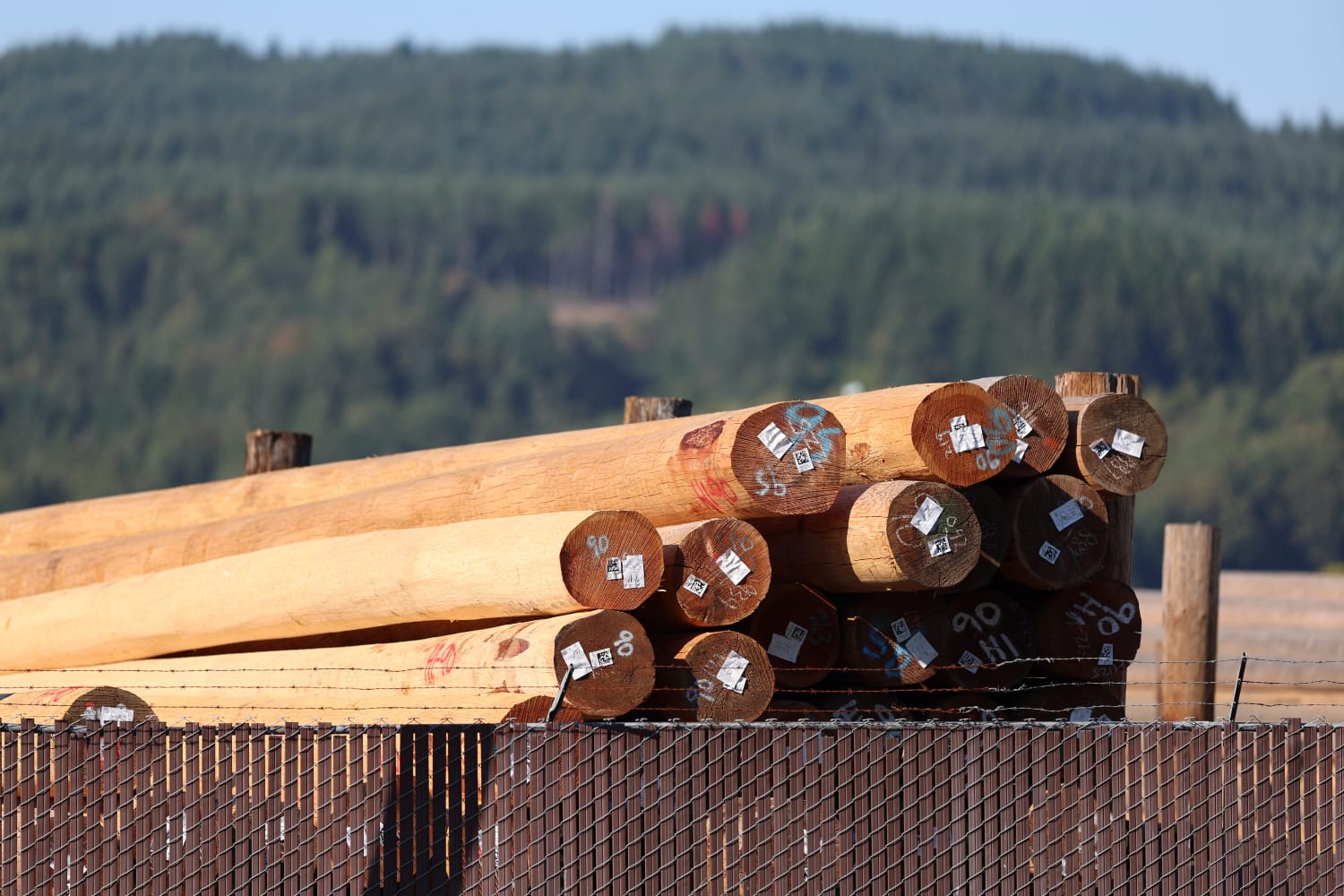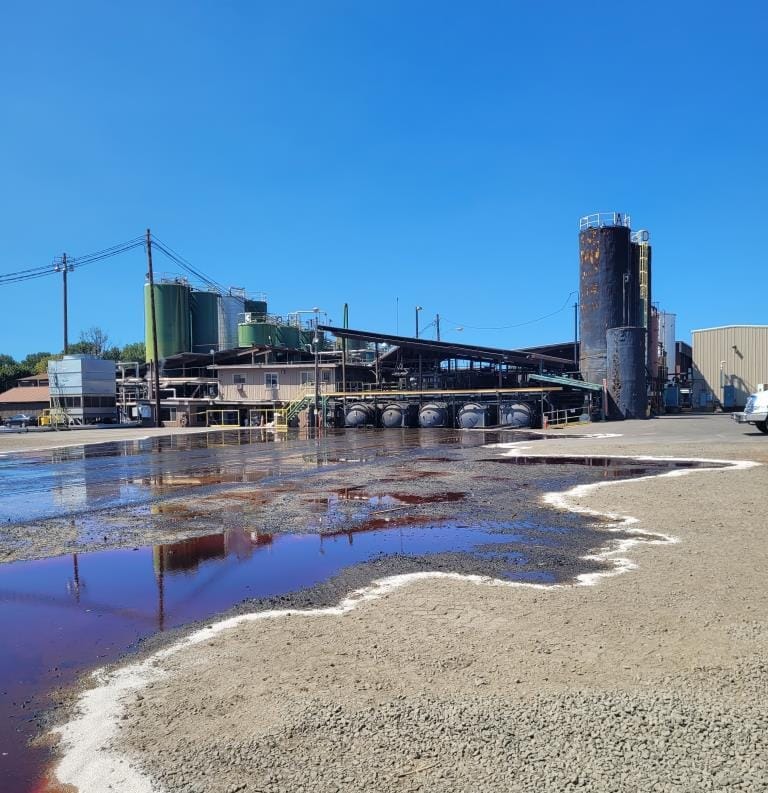Idaho prison system reopens sexual abuse case, reverses finding after InvestigateWest reporting
Woman whose allegations sparked others to speak up says Idaho still must do more to create "just and humane" system
Nearby tribe calls on state, federal agencies to end a “decade-long pattern of reckless violations”

After decades trapping crayfish in northwest Oregon, Mike Hailey could tell when something was wrong.
In the summer of 2023, Hailey noticed crayfish had disappeared downriver from a wood treatment facility in Sheridan operated by the Stella-Jones Corporation, a multinational Canadian company. Further up, his traps filled in an hour. But downstream, as the South Yamhill River flowed toward town, they were empty, his bait untouched.
“This concerns me,” Hailey wrote in a complaint to the Oregon Department of Environmental Quality on Aug. 22. “Is there something going on in the South Yamhill River that would be a contributing factor?”
Hailey never got an answer to his question. But both state and federal regulators knew something was wrong the summer he shared his concerns.
The wood treatment facility, a vestige of Sheridan’s faded timber industry, is already a Superfund site because of decades-old contamination from a likely carcinogenic wood preservative called pentachlorophenol. Unbeknownst to Hailey and many others in Sheridan, state and federal regulators have spent the last four years investigating Stella-Jones over new contamination tainting the Superfund site and the South Yamhill — a source of drinking water for nearly 6,000 residents.
On Aug. 25, Stella-Jones pleaded guilty to 10 misdemeanor charges of unlawful water pollution brought by the Yamhill District Attorney’s Office and prosecuted by a state Department of Justice environmental crime expert. As part of a plea agreement, the company has agreed to pay a maximum of $250,000 in fines to resolve a few months of pollution. It’s the first state penalty against the company despite nearly four years of violations flagged by DEQ.
InvestigateWest interviewed Sheridan residents, environmental advocates and state regulators, and reviewed decades of public records — including inspection reports, regulatory violation notices, and a preliminary federal report on the contamination. Taken together, they reveal how DEQ kept potential contamination of the town's water supply hidden from the public while failing to take measures to stop Stella-Jones from releasing more contaminated water.
DEQ has repeatedly warned Stella-Jones that stormwater it has released into the South Yamhill River over the last four winters contained too much pentachlorophenol. Although Oregon law empowers the agency to stop companies such as Stella-Jones from releasing contaminated stormwater through civil orders or permit revocation, DEQ continued to allow Stella-Jones to dump polluted water into the South Yamhill — even as it worked with prosecutors to build the criminal negligence case.
DEQ has not yet levied any civil penalties against Stella-Jones for violations stretching back to 2022. But in the case of another polluting wood treater – and under pressure from community advocates – DEQ imposed steep penalties while consulting with residents and other agencies to investigate health and environmental risks.

Regulators could also share some of the blame for the contamination. The Environmental Protection Agency briefly banned pentachlorophenol use at the site during the Superfund cleanup, but reversed that decision, as did DEQ. EPA has also known since 2022 that its own measures to contain decades-old pollution created by a previous owner of the site are failing, and it will likely be years before the agency even has a plan to clean up the new contamination.
Meanwhile, pentachlorophenol and its byproducts are spreading, sometimes in hazardous amounts, beyond the wood treatment facility and into nearby waterways, near a Head Start preschool and a home across the road, according to a draft EPA report obtained in July by InvestigateWest. Investigators initially found Stella-Jones is probably to blame for at least some of the pollution, though the agency still hasn’t released the results of the 3-year-old investigation to the public.
Two years after Hailey sent his letter, state and federal regulators haven’t explained what level of risk the pollution poses to Stella-Jones workers, Sheridan residents or the environment. No state agency has studied the health of the South Yamhill River, which serves as the spawning ground each fall for tens of thousands of threatened steelhead trout, coho salmon and Pacific lamprey.
“They aren’t being honest with people,” Hailey said after learning of the repeated violations and protracted regulator response. “I should get to make that decision if I wade into their chemicals. But, if they keep it a secret, I mean, that’s wrong.”
Dylan Darling, a spokesperson for DEQ, denied that the agency has kept information about pollution hidden from the public. He said the agency has kept the city and Stella-Jones’ neighbors apprised of any violations that “may pose a risk to public health and the environment” and has responded to questions from the public.
“We've been trying to make sure that all those who need to know about this know,” he said.
The state agency also asserted that the draft EPA report doesn’t show “any unacceptable impact to the river” caused by the facility and that it would follow-up with Hailey after the federal probe is finalized.
Nina Bell, who has sued environmental regulators over water quality enforcement as the executive director of the nonprofit Northwest Environmental Advocates, said Hailey’s report alone should have triggered swifter action.
“Frankly, if DEQ can’t act on that, it really makes you wonder what they're good for,” she said. “There’s nothing subtle about no crayfish.”
By assuming responsibility for some of the violations, Stella-Jones has agreed to clean up a contaminated drainage ditch that flows into the South Yamhill and to make other upgrades to its stormwater treatment system.
Stella-Jones did not respond to interview requests or a list of detailed questions about its alleged violations for this story. In a statement, a spokesperson said the company was “pleased” to have reached an agreement with prosecutors.
“Environmental compliance is a core priority for Stella-Jones,” said Eric Vachon, Stella-Jones’ CEO. “We have invested in people, technology and processes to ensure the Sheridan facility operates safely and responsibly for the long term and will continue to take steps to meet the highest standards across our operations.”
Urgency is mounting from other interested parties. The Confederated Tribes of the Grand Ronde — whose reservation lies a few miles upstream of the site and whose ceded lands include the city of Sheridan — called on both the EPA and DEQ in July to move quicker to stop the spreading pollution.
“The Tribe is very concerned about the apparent ongoing (Stella-Jones) mismanagement and failure to comply with current DEQ and EPA permitted program oversight,” tribal officials wrote in response to the EPA’s draft report. “The Tribe demands EPA take action to immediately end the current operator's decade-long pattern of reckless violations that continue to put Tribal people and resources at serious and unnecessary risk.”

In 2011, officials with the EPA and DEQ faced a crossroads in their oversight of Sheridan’s wood treatment facility.
The EPA had just spent 10 years and millions of dollars cleaning up decades of pentachlorophenol pollution on the property, which was operated by a company called Taylor Lumber and Treating from 1946 until the property was designated a Superfund site in 2001. Regulators had hauled off five acres of contaminated soil, cleaned out roadside ditches flowing into the South Yamhill and contained a plume of contaminated groundwater underneath the property within an underground wall topped with an asphalt cap.
Wood treaters like Taylor Lumber and Stella-Jones use preservatives such as pentachlorophenol to protect utility poles, railroad ties and other lumber products from fungus and insects. The chemical was restricted to industrial use in the U.S. in the 1980s.
The EPA’s Superfund program cleans up chemicals that pose a risk to human health, and pentachlorophenol fits the profile for its cancer-causing potential. It is toxic to the liver and associated with increased risks of cancer, particularly non-Hodgkin lymphoma and multiple myeloma, according to the National Institutes of Health. The byproducts of its use in wood treatment, called dioxins and furans, are even more likely to cause cancer. Studies on animals and humans have shown that chronic exposure to pentachlorophenol through ingestion, inhalation or skin contact can all pose risks. A 2004 study also found that pentachlorophenol accumulated in the tissue of developing salmon eggs and the embryos showed signs of stress and altered metabolism.
A new company that took over Sheridan’s wood treatment plant in 2002, Pacific Wood Preserving, used a less toxic preservative, copper naphthenate, because the EPA and DEQ banned pentachlorophenol use at the site during the cleanup.
But by 2011, Pacific Wood had hit a snag: Products treated with copper naphthenate didn’t sell as well, and the supply of the chemical had dwindled. The company told state and federal regulators it needed to use pentachlorophenol in order to keep operating.
In public comments to the EPA, locals supported the shift back to pentachlorophenol, emphasizing the crucial economic role of the facility in an area hurt by the decline of timber. But one letter from a Portland environmental attorney named Brian King expressed concern that history would repeat itself if the chemical was allowed again.
“Nothing has changed since 2001 when the community expressed concern over the use of (pentachlorophenol) and other highly toxic chemicals at the site,” King’s letter said. “The risks to human health and the environment from the use of these chemicals are no different now than they were ten years ago.”
The EPA waved aside King’s concerns, saying the agency had not identified “any added risks to human health or the environment.” It lifted its ban on pentachlorophenol use at the site. A month later, in June 2011, DEQ followed suit.
Pacific Wood’s continued presence on-site would save the EPA and DEQ money because the property owner is responsible for maintaining some of the pollution containment measures, the EPA said. Keeping the ban in place, regulators said, would “penalize the company, its workers, and the local economy without generating any substantial environmental benefit.”
McFarland Cascade Holdings, a subsidiary of the Stella-Jones Corporation, bought the site just two years later. It took only another couple of years for problems with pentachlorophenol to start popping up, DEQ records show.
Stella-Jones discharged unlawfully polluted stormwater in 2015, 2016 and 2017, drawing state fines totaling $16,000. DEQ said each violation “may have negatively impacted water quality in the South Yamhill River.”
State officials may levy higher penalties for repeat violations of a water quality permit, which DEQ has done with other permit holders. Instead, records show, DEQ settled with Stella-Jones to lower the original fines by over $2,000.
For the next five years, Stella-Jones continued using pentachlorophenol with no violations.
In February 2022, the EPA announced a five-year phased ban on pentachlorophenol use nationwide, ordering wood treatment companies to wean off using the chemical by February 2027.
“The risks pentachlorophenol poses to workers’ health outweigh the benefits of its use,” the EPA said in its decision, pointing to viable alternatives that wood treaters could use. As Stella-Jones worked to meet the EPA’s requirements by gradually incorporating a less-toxic chemical called DCOIT, problems with its ongoing pentachlorophenol use resurfaced: Once again, the company was releasing polluted stormwater.

The first pentachlorophenol-contaminated sample came in January 2022, and violations continued intermittently each winter after that through 2024. In the first three months of 2024 alone, Stella-Jones racked up 14 violations for pentachlorophenol pollution in a drainage ditch that flows into the South Yamhill River. Several factors may account for continued water quality problems even after the company stopped using pentachlorophenol, including old contaminated groundwater escaping the containment wall and the residue from repeated chemical spills at the site.
From the winter of 2022 through 2024, Stella-Jones reported 17 such spills. In several instances, employees had simply overfilled storage tanks or the evaporator, splashing pentachlorophenol-saturated oil and wastewater onto the ground, according to spill reports. The largest spill was in August 2023, involving more than 2,400 gallons of diesel mixed with DCOIT. That spill caught residents' attention because, according to regulators, the mixture had entered a storm drain and a men’s urinal onsite, reaching the city of Sheridan’s sanitary sewer and triggering a coordinated cleanup involving local, state and federal officials. DEQ inspectors found at least five additional instances where Stella-Jones had failed to report spills in violation of the law, according to agency documents.
State inspectors also found the company had, on multiple occasions, downplayed the amount of tainted wastewater or diesel that had seeped into drains and ditches and at times did not adequately clean equipment. As a result, contaminants had on different occasions seeped into the asphalt cap helping contain the already-polluted groundwater, tainted the stormwater system or entered the South Yamhill River.
In their written warnings, DEQ officials ordered Stella-Jones to correct its practices, including testing stormwater releases more frequently. But sometimes the company even failed to do that. From December 2022 to April 2023, Stella-Jones fell behind on reporting sampling data for several weeks. This, too, prompted warnings from regulators, but no penalties yet.
In April 2024, Sheridan resident Christina Avila also wrote to DEQ asking whether her town’s drinking water was safe. She had heard the August 2023 spill at Stella-Jones mentioned during a couple of recent City Council meetings.
“As a homeowner here in Sheridan and as a parent of a daughter who’s a student at the boarding school directly behind Stella-Jones, I’m very concerned,” she wrote. “Is there updated information I can receive about the spill or Stella-Jones?”
DEQ staff reassured her that no impacts to drinking water had been detected and that the school was safe, as well.
“Contaminated groundwater is mostly contained on the facility,” said Nancy Sawka, a cleanup program manager, in response to Avila’s email. “Any stormwater is treated to acceptable levels prior to discharging to the river.”
But Sawka didn’t mention that a month prior, DEQ had looped in its enforcement office to impose civil penalties over more than 84 instances where Stella-Jones had violated environmental regulations — though sixteen months later DEQ is still working on those penalties.

Erin Saylor, interim manager of the enforcement office, said it’s taken a long time to finish because the case is so complicated.
“Enforcement is a very important tool for protecting Oregon’s environment,” Saylor said in an email. “However, building an effective enforcement case takes time.”
The agency is crafting a response that addresses the violations and ensures the company stays in compliance going forward, she said.
For the past three years, DEQ has ordered Stella-Jones to take steps to investigate and prevent continued pollution. But it hasn’t jeopardized the company’s permit or told it to stop discharging stormwater into the river.
Darling, DEQ spokesperson, said if the agency had revoked Stella-Jones’ permit or ordered the company to store untreated stormwater, it would have likely resulted in more spills.
“It rains a lot in Oregon,” he said. “The system isn’t designed to take in rainfall in large quantities. We need the permit in place to regulate what’s being done there and get it up to compliance.”
Bell, the environmental advocate, called that explanation “very simplistic” and said pollution source control is part of DEQ’s responsibility.
Although the state agency has yet to issue civil penalties against the wood treater, it tipped off the Oregon State Police about potential criminal negligence by the company and assisted in the investigation that resulted in nearly two dozen misdemeanor charges against Stella-Jones last December. The $250,000 fine negotiated by prosecutors and Stella-Jones attorneys — $50,000 of which will be dismissed if the company stays out of trouble for the next three years — is less than half a percent of the corporation’s 2024 net profit, which surpassed $230 million, according to financial statements.
In court Aug. 25, Stella-Jones’ attorney, Per Ramfjord, said the company will spend “millions” more than the penalty amount in order to meet the demands of the probation agreement, which includes cleanup and upgrades to the stormwater treatment system. The company already began evaluating and updating the system this year in response to DEQ demands.
“We believe the company is taking responsibility and it wants to take responsibility,” Ramfjord said.
Stella-Jones’ guilty plea is a shift from its posture with state regulators — in correspondence with DEQ, the company has disputed many of the violations, accusing state regulators of stalling its requests for clarification and interfering with its business. Company leaders also suggested the water pollution stems from the EPA’s failure to manage the Superfund site, rather than the company’s more recent use of pentachlorophenol. In letters responding to state regulators, the company cited the EPA’s 2022 finding that its containment of decades-old groundwater pollution was failing, and urged Oregon officials to hold off on any penalties until federal regulators complete their investigation. It’s not clear when it will be complete.
“To the extent the EPA remedy may be failing or inadequate, any resulting noncompliance should not be attributed to Stella-Jones,” wrote Heather Gawne, Stella-Jones’s environmental compliance manager, in a July 2024 letter.
But at least some of the contamination may be pinned on Stella-Jones, according to a draft of the EPA’s investigative report that InvestigateWest obtained in a public records request. Tainted sediment in the roadside ditch where the company’s water quality violations recur, for example, appears to be linked to Stella-Jones operations. Stella-Jones spills are also the most likely cause of other sediment and soil contamination across the property, the draft report found.
Draft report data also showed that dioxin contamination on the site was, in some places, thousands of times higher than Oregon’s occupational exposure limits. Darling, the DEQ spokesperson, said Stella-Jones cleaned up contaminated soils in areas where employees work, but it's not clear how long workers were exposed to dioxin prior to that.

Dioxin contamination also is not limited to the property. Sediment samples from an adjacent creek, and soil samples from a nearby residence and a Head Start located kitty-corner to the Stella-Jones property, also showed dioxin concentrations reaching as much as 10 times Oregon’s residential exposure limit. Prompted by this data, DEQ conducted more extensive testing in 2023 and 2024 on the playground of the Head Start, Darling said. The agency found lower levels of dioxin there, which Oregon Health Authority toxicologists believed posed a limited risk of exposure, he said.
Federal regulators are also analyzing new sampling showing that the historically contaminated groundwater is escaping the EPA’s containment measures and is migrating to the east, likely tainting soil as it moves.
Once the final report is released, the agency will then decide how to manage the cleanup and how costs should be split between the agency and Stella-Jones, a process that could stretch on for another few years.
So far, the only enforcement action the EPA has taken against Stella-Jones is for its failures to maintain an adequate spill prevention plan and train workers under the federal Clean Water Act.
According to an agreement with the agency announced in July, Stella-Jones neither denied or admitted the EPA’s allegations. But it accepted a $98,000 penalty.
Two hours south of Sheridan, state and federal regulators have more closely scrutinized the impacts of pentachlorophenol and dioxins on human health and the surrounding environment.
At a site run by J.H. Baxter, a now-defunct wood treater in west Eugene, regulators found the company had also spilled pentachlorophenol and other chemicals, polluting soil and groundwater. Beyond that, employees had tried to illegally dispose of hazardous waste by evaporating wastewater out of the treatment system, prompting air quality concerns from residents living nearby in west Eugene and Bethel. Last year, it became the focus of a “time-critical” EPA cleanup to remove hundreds of gallons of hazardous chemicals from the site, and in July, it became a Superfund site.
Local advocates in west Eugene complained about smells, difficulty breathing and unexplained diseases for years before officials began taking action. Arjorie Arberry-Baribeault was one of them.
She became an advocate for an environmental justice nonprofit, Beyond Toxics, after her daughter’s Hodgkin lymphoma diagnosis made her suspicious about environmental risks from the J.H. Baxter plant. She and other organizers spent years pushing for environmental and health officials to investigate their exposures to chemicals from J.H. Baxter.
Arberry-Baribeault said it doesn’t surprise her that in Sheridan, residents might not yet be aware of the contamination from the Stella-Jones facility and how it could impact workers or neighbors. But accountability might not come unless residents ask hard questions.
“(Regulators) do take a long time. It’s not their yard, not their kids, not their pets … so there’s no urgency there,” she said.
Community involvement helped spur the Oregon Health Authority to conduct health assessments in the area, including a cancer study that found residents in west Eugene had slightly higher levels of lung cancer and Hodgkin lymphoma than residents in other areas of the county and state. The analyses also found dioxins in the soil of residential yards surrounding J.H. Baxter was posing varying levels of risk to neighbors.
When public health officials presented the study results to the community, they displayed a graphic using stick figures to illustrate how many people out of the group might be likely to get cancer.
“I was like, wait a minute, those are not just stick figures on your screen, those are people,” she said. “And one of those people is my child. So, bringing back that humanity to the situation is uncomfortable for (state officials), but it’s also necessary to make changes.”
DEQ referred J.H. Baxter’s laundry list of violations to the EPA for investigation in 2020 and levied more than $220,000 in civil fines the next year. In April, the company was ordered by a federal court to pay $1.5 million in criminal penalties, and its president was sentenced to 90 days in prison after pleading guilty to lying to DEQ officials.

Compared to J.H. Baxter, pollution at the Stella-Jones site has gone largely unnoticed by Sheridan residents. City leaders who have been aware of various spills have asked some questions about impacts to public health, said Ian Houston, a city councilor who stressed he wasn’t speaking in an official capacity. But amid turnover in city leadership, few answers have emerged.
Public drinking water data indicates that Sheridan’s drinking water meets health and safety requirements, but the city does not test for dioxins and has not tested for pentachlorophenol since late 2022. City officials did not respond to multiple interview requests for this story. While Sheridan draws drinking water from the South Yamhill River primarily in the summer rather than during the rainy winter months when Stella-Jones discharges stormwater into the river, local residents also fish and swim in it.
Some are calling for more investigation into how the pollution could be impacting the environment. Officials with the Confederated Tribes of Grand Ronde urged the EPA in July to address potential health impacts to fish and other species in the South Yamhill, and to protect the Superfund site.
“Neither the tribe nor the Oregon taxpayers deserve this avoidable risk to human health and the environment,” the letter said.
But the tribe and Sheridan residents won’t know much more until the EPA releases its report or DEQ completes its enforcement action. For now, they wait.
“There’s not really a lot to talk about, I guess, other than you hope that somebody is going to do something,” Houston said.
The story you just read is only possible because readers like you support our mission to uncover truths that matter. If you value this reporting, help us continue producing high-impact investigations that drive real-world change. Your donation today ensures we can keep asking tough questions and bringing critical issues to light. Join us — because fearless, independent journalism depends on you!
— Jacob H. Fries, executive director
DonateCancel anytime.
Subscribe to our weekly newsletters and never miss an investigation.
From now until Dec. 31, NewsMatch and a generous local donor will each match community donations, matching your new monthly donation 12 times or TRIPLE your new one-time gift, all up to $1,000.
Cancel anytime.